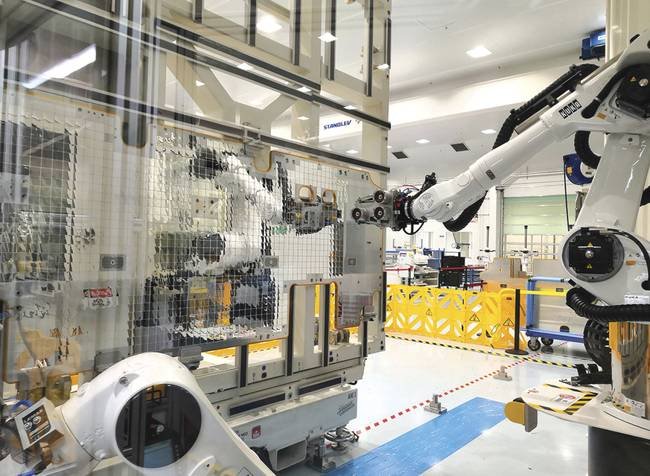Traditionally, fitting optical solar reflectors (OSRs) to satellite panels, a crucial step for thermal control in high-radiation environments, was a manual and labor-intensive process. Workers meticulously positioned strips of OSRs, ensuring precise alignment. To enhance efficiency, automation company AKEOPLUS, collaborating with space manufacturer Thales Alenia Space, engineered an automated robotic solution. This system, named “SOLAR,” operates within a cleanroom environment and utilizes machine vision to accurately place OSRs on satellite panels.
The SOLAR robotic cell, developed by AKEOPLUS, incorporates MVTec’s HALCON machine vision software to achieve the required precision in OSR placement. Each panel, measuring 6 × 3 meters, is processed within a 7 × 5 meter working area. Robots within the cell are tasked with applying up to 7,000 small OSRs, each 40 × 43 mm, to the panels with an accuracy of less than 0.2 mm. While acknowledging limitations in the robots’ inherent movement precision, AKEOPLUS and Thales Alenia Space innovatively overcame this through the integration of advanced technology.
Each SOLAR cell comprises two robots, a positioning table for the satellite panels, a laser tracker for precise guidance of a six-axis robotic arm, and three high-resolution 2D cameras for industrial image processing. HALCON software plays a critical role managing quality inspection of OSRs, fine-tuning positioning, facilitating human-machine interaction, and providing visualization. The combination of machine vision and laser tracking establishes a precise dimensional control loop, enabling visual servoing between the robot and target position, according to Maxime Motisi, CFO and project manager of the SOLAR robotic cell at AKEOPLUS.
The manufacturing process begins with a smaller robot placing an OSR onto a vacuum backlight under the first camera. HALCON software analyzes the image captured by the camera to check for defects like breaks or scratches. Shape-based matching techniques are then used to pinpoint the OSR’s precise location and verify its dimensions against the intended model. HALCON ensures alignment accuracy within approximately 0.2 mm before glue is applied. The OSR is then transferred to a station where a larger robot takes over, transporting it to another processing station. Here, HALCON analyzes the glue pattern to confirm even distribution according to a predefined pattern.
For the final alignment, the OSR is positioned at a third camera station where HALCON algorithms determine the 3D transformation between the OSR’s corner coordinates and the robot gripper’s coordinate system. By identifying the corners of the OSR, HALCON defines a coordinate system, using a corner as the center point aligned with the edges. This coordinate system is crucial for accurate 3D alignment, compensating for potential tilts of the reflector held by the gripper. The OSR corner also serves as a reference point for precise placement on the satellite panel. The laser tracker and HALCON working in conjunction enable the robot to mount the OSR to the exact location on the large 18-square-meter panel with the required accuracy, correcting for any inaccuracies.
AKEOPLUS conducted lighting studies in 2017 to optimize the system’s vision capabilities. Backlighting is used for initial defect inspection and dimension checks. Low-angle lighting is employed at other camera stations to clearly identify the OSR corners against a light background for relocation purposes. Blue light, combined with low-angle illumination, is utilized during glue inspection to enhance contrast and identify white glue on the reflector’s mirrored surface.
The SOLAR cell system, integrating HALCON software, has achieved an overall equipment effectiveness exceeding 95%, according to AKEOPLUS. This significantly improves upon the previous manual process, where completing one large panel took two employees approximately seven days. In comparison, the automated system enables a single employee to complete a similar panel in five days. AKEOPLUS highlights features like 3D positional determination and subpixel-accurate shape-based matching as key factors contributing to the system’s ease of use and efficient integration. Motisi stated that HALCON is employed in almost every innovative machine AKEOPLUS develops, with roughly 75% of its HALCON usage dedicated to relocating 6D robots in 2D or 3D, 15% in inspection applications, and 10% in bin picking and collision avoidance.

Leave a Reply